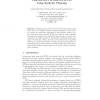Free Online Productivity Tools
i2Speak
i2Symbol
i2OCR
iTex2Img
iWeb2Print
iWeb2Shot
i2Type
iPdf2Split
iPdf2Merge
i2Bopomofo
i2Arabic
i2Style
i2Image
i2PDF
iLatex2Rtf
Sci2ools
AGI
2015
2015
Plan Recovery in Reactive HTNs Using Symbolic Planning
Building formal models of the world and using them to plan future action is a central problem in artificial intelligence. In this work, we combine two well-known approaches to this problem, namely, reactive hierarchical task networks (HTNs) and symbolic linear planning. The practical motivation for this hybrid approach was to recover from breakdowns in HTN execution by dynamically invoking symbolic planning. This work also reflects, however, on the deeper issue of tradeoffs between procedural and symbolic modeling. We have implemented our approach in a system that combines a reactive HTN engine, called Disco, with a STRIPS planner implemented in Prolog, and conducted a preliminary evaluation.
| Added | 13 Apr 2016 |
| Updated | 13 Apr 2016 |
| Type | Journal |
| Year | 2015 |
| Where | AGI |
| Authors | Lydia Ould Ouali, Charles Rich, Nicolas Sabouret |
Comments (0)

